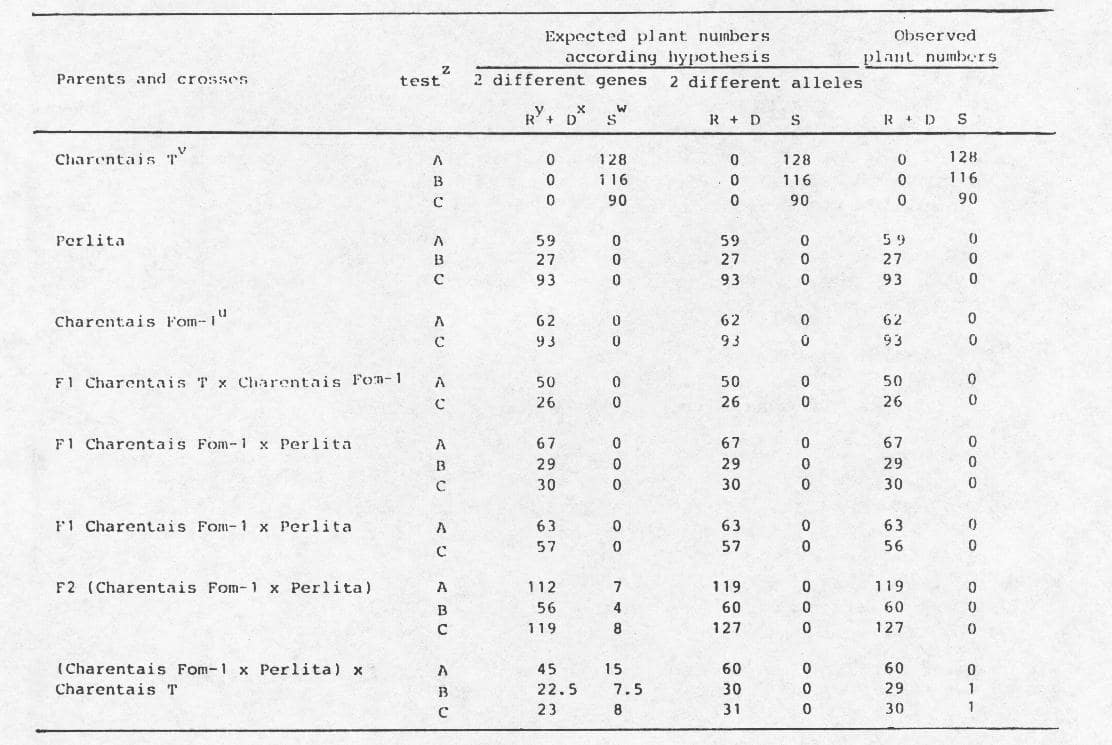Cucurbit Genetics Cooperative Report 10:60-61 (article 32) 1987
G. Risser
Institut National de la Recherche Agronomique 84140 Avignon-Montfavet, France
In 1985, Zink and Gubler (3) reported that ‘Perlita’ resistance to Fusarium wilt (Fusarium oxysporum f. sp. melonis) races 0 and 2 is conferred by a dominant gene Fom-3 different from the gene Fom-1 that controls resistance to races 0 and 2 in ‘Doublon’ (2).
Actually, resistance of ‘Perlita’ appears different from that of ‘Doublon’ in our experience. When inoculated by our usual method (1) ‘Perlita’ exhibits a very fluctuating reaction : usually, cotyledons are yellowing, then sometimes, young leaves are yellowing too and seldom apex dies; so, in one experiment, we can observe resistant and susceptible seedlings and reaction of the same line is very fluctuating according the experiment. This heterogeneity is observed in every accession of ‘Perlita’ that we have received and is carried on after several self pollinations, so we cannot attribute it to genetic heterogeneity. We cannot control heterogeneity of ‘Perlita’ reaction by using different inoculum concentrations or seedling stages at innoculation but using growth chamber with more light than usual allows ‘Perlita’ to exhibit a more regular resistance.
If expression of ‘Perlita’ resistance appears different from that of ‘Doublon’, observed segregations in progenies from crosses between ‘Perlita’ and a line with gene Fom-1 from ‘Doublon’ do not agree with the hypothesis of two different genes if we select experiments where no plants of ‘Perlita’ are noted as susceptible (table 1).
So our results do not agree with those of Zink and Gubler (3) but 2 hypothesis can explain them: ‘Perlita’ has an allele of Fom-1 different of the allele of ‘Doublon’ and ‘Charentais Fom-1‘ or the genetic background of ‘Perlita’ does not allow Fom-1 to act well. Studies are going on to decide which of the hypothesis is the good one.
I would be happy to receive results of other breeders who are using ‘Perlita’ as parent.
Table 1. Segregation in progenies from crosses between Perlita and Charentais T or Charentais Fom-1 after inoculation with races 0 or 2 of Fusarium oxysporum f. sp melonis.

z Test A plantlets inoculated with race 0; test B and C plantlets inoculated with race 2
y R=resistant plant without symptoms
x D=doubtful plant with some yellowing but without wilt or collapse
w S=susceptible plant : wilting or died
v Charentais T is a line susceptible to races 0,1,2 and 1-2 of Fom
u Charentais Fom-1 is a quasi isoline of Charentais T, bred by backcrossing Doublon to Charentais T
Literature Cited
- Risser, G., and P. Mas. 1965. Mise en èvidence de plusieurs races de Fusarium oxysporum f. sp. melonis. Ann. Amèlior. Plantes 15:405-408.
- Risser, G., Z. Banihashemi, and D.W. Davis. 1976. A proposed nomenclature of Fusarium oxysporum f. sp. melonis races and resistance genes in Cucumis melo. Phytopathology 66:1105-1106.
- Zink, F.W., and W.D. Gubler. 1985. Inheritance of resistance in muskmelon to Fusarium wilt. J. Amer. Soc. Hort. Sci. 110:600-604.